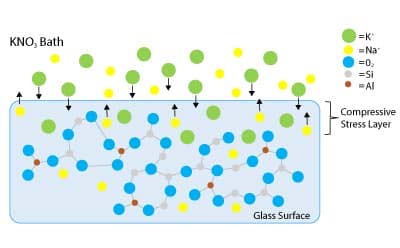
Chemical Strengthening of Glass
Coresix performs chemical strengthening by inducing an exchange between the larger Potassium ions of the chemical bath and the smaller Sodium ions of the glass. The resulting compacted surface stress greatly increases the strength of the glass without optical distortion. In addition to the traditional methods of verifying the post strengthening results, including drop-ball and compression testing, Coresix has a unique, non-destructive means of measuring the surface stress and ion exchange depth of the process. We can correlate this test with any required standard, providing the customer with real data to quantify the strengthening results.

Chemical Strengthening Process
Glass breaks from flaws on its surface when there is tension on the glass. Glass is strengthened through the ion-exchange process. During this process, glass is submerged in a bath containing a potassium salt (typically potassium nitrate) at 300 °C (572 °F). This causes sodium ions in the glass surface to be replaced by potassium ions from the bath solution. The Potassium ions in the solution migrate into the glass surface and replace the smaller sodium ions within the glass structure. The larger potassium ions then create a compressive stress layer that forms an extremely tough surface.
Chemical Strengthening enables glass to retain more of its strength even after a minor nick or scratch and protects it from more cracks and flaws.